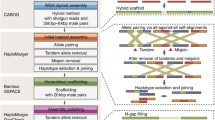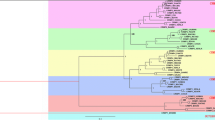Abstract.
Calpains, the Ca2+-dependent intracellular proteinases, are involved in the regulation of distinct cellular pathways including signal transduction and processing, cytoskeleton dynamics, and muscle homeostasis. To investigate the evolutionary origin of diverse calpain subfamilies, a phylogenetic study was carried out. The topology of the calpain phylogenetic tree has shown that some of the gene duplications occurred before the divergence of the protostome and deuterostome lineages. Other gene doublings, leading to vertebrate-specific calpain forms, took place during early chordate evolution and coincided with genome duplications as disclosed by the localization of calpain genes to paralogous chromosome regions in the human genome. On the basis of the phylogenetic tree, the time of gene duplications, and the localization of calpain genes, we propose a model of tandem and chromosome duplications for the evolution of vertebrate-specific calpain forms. The data presented here are consistent with scenarios proposed for the evolution of other multigene families.
Similar content being viewed by others
Author information
Authors and Affiliations
Additional information
Received: 17 November 1998 / Accepted: 30 April 1999
Rights and permissions
About this article
Cite this article
Jékely, G., Friedrich, P. The Evolution of the Calpain Family as Reflected in Paralogous Chromosome Regions. J Mol Evol 49, 272–281 (1999). https://doi.org/10.1007/PL00006549
Issue Date:
DOI: https://doi.org/10.1007/PL00006549




